Wind Turbine Controllers
Basic Wind Turbine Controllers.
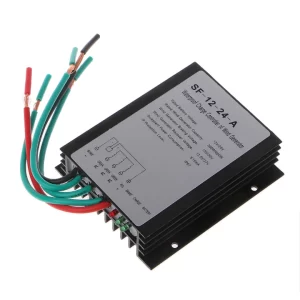
Rated Battery Voltage: 12/24/48 volt
Rated Power: 300 – 600 watts
Brake Voltage: 15/30/60V
Recovery Voltage: 13.5/27/54V
Max Input Current: up to 30A depending on the model
Waterproof Grade: IP67
Size: 100 x 90 x 30mm
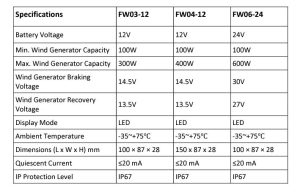
LED Indicators:
- Green battery light is on = Battery connection is normal
- Green wind generator light is on (constant) = Wind generator connection is normal
- Green wind generator light is on (flashing) = Speed of flashing indicates the rotation speed of the wind generator
- Red brake light is on = Automatic brake mode enabled due to fully charged battery OR over-current protection function has been enabled
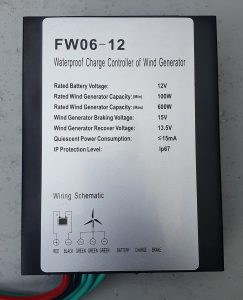
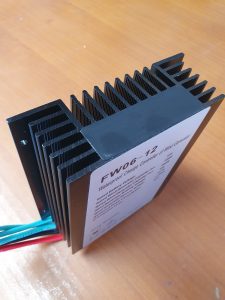
| Model | Prices May 2024 |
| FW03-12 | $125 |
| FW04-12 | $125 |
| FW06-24 | $125 |
| FW06-12 | $260 |
WWS Hybrid Wind Solar Controllers.
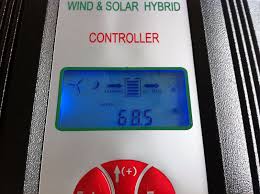
- The wind/solar hybrid controller is an intelligent apparatus that is specially designed for high-end small-scale wind/solar hybrid systems.
- Especially suitable for wind/solar hybrid systems, and wind/solar hybrid monitoring systems. It can simultaneously control a wind turbine and solar panels to charge a battery safely and efficiently.
- Neat appearance, easy operation, visual LCD display, and many protection functions, it has high charge efficiency and low no-load loss.
- The system operation will be safe, stable, and reliable.
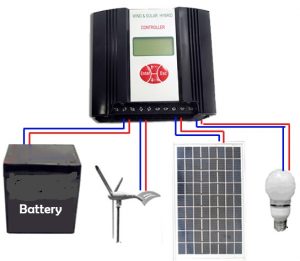
Performance Description
Reliability: Intelligent, modular design, simple mechanism, powerful functions. With industrial range superior components and strict production technology, the controller can be used in relatively bad working environments and has reliable performance and a long lifespan.
PWM Stepless Dumpload Mode: When the power generated by the wind turbine and solar panel exceed battery capacity, the controller will release residual power. The common control mode is to dumpload all the power. However, the battery is not full actually. That all the power was consumed via resistors makes resources tremendously wasteful. Even with staging dumpload into five or six stages, the effect is still not ideal. Our company adopts PWM (Pulse Width Modulation) step-less dumpload mode. In other words, the controller can dump residual power with division into thousands of stages. It can dump residual power while charging battery banks, which is beneficial in extending battery life.
Voltage Limiting and Current Limiting Charge Mode: When the battery voltage exceeds the pre-set dumpload voltage point, the controller will adopt PWM voltage limiting charge mode. It dumps the excess energy in order to extend the battery life. When the wind turbine charging current exceeds the pre-set brake current point, the controller will automatically start the brake to protect the battery. (e.g.: WWS06-48-N: If the battery voltage exceeds the charge shutoff voltage or the wind turbine current exceeds the wind turbine brake current, the controller will automatically start the brake.)
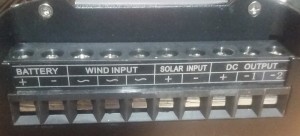
Wind charger controller connection terminals
Two DC Outputs: Each DC output has independent control modes including: Constant on; Constant off; Constant half-power; light-control on, light-control off; light-control on, time-control off; light-control on, time-control half-power, light-control off; light-control on, time-control half -power, time-control off. Users can set three output control modes by LCD buttons: constant on; light-control on, light-control off; light-control on, and time-control off.
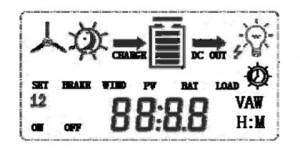
wind charge controller display
LCD Display Function: The LCD screen displays system status and parameters via both digital and graphic forms. Displayed are: battery voltage, wind turbine voltage, PV voltage, wind turbine current, PV current, wind turbine power, PV power, load current, and output control.
MPPT controller option: The MPPT controller option is now available with an MPPT charge control circuit to ensure the maximum input to your batteries regardless of the speed of the wind generator and solar input condition.
Comms now available: The controller is available with a serial port or RS485 output to allow you to view the outputs of the controller on a remote computer. The software is supplied on a cd.
Wws Wind Generator Controller Model Specifications
| WWS 03-12 | WWS 04-12 | WWS 04-24 | WWS 06-24 | WWS 06-48 | |
| Battery voltage | 12 | 12 | 24 | 24 | 48 |
| Rated turbine power | 300 w | 400 w | 400 w | 600 w | 600 w |
| Max turbine power | 450 w | 600 w | 600 w | 900 w | 900 w |
| Rated solar input power | 150 w | 150 w | 300 w | 300 w | 200 w |
| Dumpload start voltage | 13.5 v | 13.5 v | 27 v | 27 v | 52 v |
| Charge shut-off voltage | 14.5 v | 14.5 v | 29 v | 29 v | 58 v |
| Wind turbine brake current | 30 amp | 40 amp | 20 amp | 30 amp | 15 amp |
| Battery over-discharge protection voltage | 10.8 | 10.8 | 21.6 | 21.6 | 43.2 |
| Dimensions | 142 x 150 x 82 | 142 x 150 x 82 | 142 x 150 x 82 | 142 x 150 x 82 | 210 x 150 x 82 |
| Weight | 1.0 kg | 1.9 kg | 1.9 kg | 1.9 kg | 2.6 kg |
| Prices PWM | $280 | $320 | $320 | $380 | $390 |
| Prices MPPT | $450 | $490 | $490 | $550 | $560 |
| RS485 coms option available | $125 | $125 | $125 | $125 | $125 |
Hybrid Controller specifications here
12v Hybrid Controller User Manual
Large WWS Wind Solar Controllers.
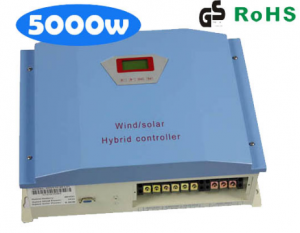
This advanced wind/solar hybrid controller is specially designed for high-end small-scale wind/solar hybrid systems, and is especially suitable for wind/solar hybrid power generation system systems, and as a wind/solar hybrid monitoring system. It can simultaneously control a wind turbine and solar panels on the same battery, offering safe and efficient charging.
The controller adopts PWM to control both wind turbine and solar panel charging of the battery, with both voltage limiting and current limiting; namely, the controller will charge the battery with current limiting when the battery power is low, and charge the battery with voltage limiting when the battery power is high.
- When the total charge current of the wind turbine and solar panels is lower than the current limiting point, the controller will charge the battery with the whole of the power generated by the wind turbine and solar panels. However, when the total charge current of the wind turbine and solar panels is more than current limiting point, the controller will charge the battery only up to the current limiting point, the excess energy being unloaded by PWM.
- When the battery voltage is lower than the voltage limiting point, the controller will charge the battery with the whole of the power generated by the wind turbine and solar panels. As the battery voltage climbs up to the voltage limiting point, the controller will only charge battery up to the voltage limiting point, and the excess power will be unloaded by PWM.
For specific wind turbines, the controller can achieve accurate speed control, namely, you can set the stop rotation speed. When the wind turbine exceeds this speed, the controller will stop the wind turbine working, and the controller will not run the wind turbine for 10 minutes.
The controller has an LCD module especially designed for wind/solar hybrid system display. The LCD can display battery voltage, wind turbine voltage, PV voltage, wind power, PV power, wind turbine current, PV current and battery power status. Users can browse the parameters through the four keys of LCD.
The controller is equipped with dedicated remote monitoring software. The software can monitor system status in real-time, such as battery voltage, wind turbine voltage, solar battery voltage, battery charging current, wind turbine charging current, solar charging current, battery charging power, solar charging power, wind turbine charging power, fan speed and so on. The software can configure and modify the system parameters, and the software can control the operation of the wind turbine and the load.
In addition, the controller has built-in protection functions, including: solar panel reverse charging, solar cells anti-reverse, battery over charge, battery anti-reverse, lightning protecting, wind turbine current limiting, wind turbine automatic brake and manual brake.
A low-voltage charging module is optional. This module enables the wind turbine to charge the battery at low wind speeds. Because the wind turbine has low energy at low speed, the charging current will be small when the fan speed is slow. The low-voltage charging module enables the wind turbine to charge the battery with constant input impedance under low-voltage charging status, namely, the charging current is proportional to charging voltage. Depending on the different characteristics of wind turbines, the input impedance can be modified through serial communication. In addition, users can set wind turbine start charge voltage point through serial communication. Only when the wind turbine voltage is greater than the wind turbine start charging voltage, the wind turbine will charge the battery. The wind turbine start charging voltage can be modified through the serial communication. The controller has intelligent and modular design, simple menu, and powerful operation. The controller uses all high quality industrial components and controlled production activity, which makes the controller suitable for relatively harsh working environments, giving reliable performance and a long service life.
| 2 kw 48 v DC | |
| 5 kw 48 v DC | |
| 7.5 kw 120 v DC | 75 kg |
| 7.5 kw 240 v DC | 75 kg |
Twelve months warranty
HR Wind Generator Controllers
The HR series of wind controllers are designed especially for small off-grid wind generation systems.
Appearance is smart, and the operation is simple. Our controllers regulate the wind generator output to charge the batteries safely and efficiently, using a unique “buck and boost” function for maximum input and safety. There is also a built-in dump load for when the batteries are full.
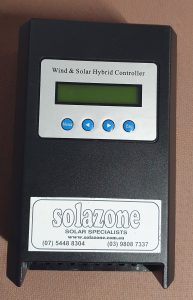
Shown: Wind controller HR600-48
Functions and Features:
- Protection from over current
If the wind charging current exceeds the maximum rated charging current, the controller will start to dump load automatically to protect the wind generator. - Intelligent limiting of the battery max current. In the system setup, you set the battery’s capacity in the controller’s program. The controller will limit the charging current to 0.3 times the battery’s capacity to protect the battery and extend the battery life (for example, if the battery capacity is 10Ah, the max. charging current is 3A).
- Manual brake function.
- Wind charging manual switch. Users can turn on/off of the wind charging.
- DC output manual switch
There are four kinds of DC output, users can set it according to their system requirements. - Built-in boost and buck functions for maximising wind charging
Boost: If the output voltage of the wind generator is less than the battery voltage, the controller increases the output voltage (but decreases the charging current) to charge the battery, this function provides some wind charging even in low wind conditions.
Buck: If the output voltage of the wind generator exceeds the controller’s limit, the controller reduces the output voltage of the wind generator (and increases the charging current) to charge the battery, and improve the charging efficiency. - Optional Anemometer function.
If you connect the controller with an anemometer, the wind speed can be displayed on LCD. - Optional RS232 or RS485 communication. (Must be ordered at the time of manufacture)
Users can monitor and set the controller on PC software through RS232 or RS485. You can monitor the whole system, store, and analyze data.
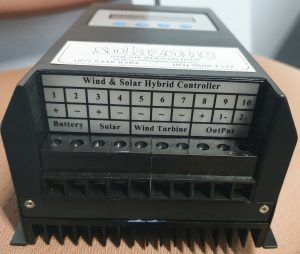
Buck and boost wind charge controller
| HR Model | 300-0-12 | 400-0-24 | 400-300-48 | 600-0-24 | 600-0-48 |
| Rated Power | 300 | 400 | 400 | 600 | 600 |
| Battery voltage | 12 | 24 | 48 | 24 | 48 |
| Max input volts | 80 | 80 | 80 | 80 | 80 |
| Max input power | 1000 | 1000 | 1000 | 1000 | 1000 |
| Boost and buck | Yes | Yes | Yes | Yes | Yes |
| Dump load | Yes | Yes | Yes | Yes | Yes |
| IP rated | No | No | No | No | No |
| Float charge volts* | 13.5 | 27.0 | 54 | 27.0 | 54 |
| Equalise voltage* | 14.7 | 29.4 | 58.8 | 29.4 | 58.8 |
| Dimensions | 203 x 152 x 98 mm | ||||
| Weight | 2.5 kg | ||||
| Prices 2023 | $535 | $535 | $565 | $588 | $588 |
-
- The charging parameters are user-adjustable and can be set according to your battery’s requirements. This means you can set it for your lithium battery if you know the charging requirements of that battery.
- For this series, the total power @48v cannot exceed 1000w, @24v cannot exceed 800w, and @12v cannot exceed 500w.
- The maximum wind input is limited to 15 amps. Similarly, the maximum solar input is limited to 15 amps.
- As an example, for a 48v controller, the max wind power input is 48v x 15a = 720w. In this case, the remaining power left available for solar input is just 280w.
- Optional RS485 port available for comms.
- These controllers can be ordered with an optional small solar input capacity. We recommend most solar systems be separately regulated.
HM Wind Generator Controllers.
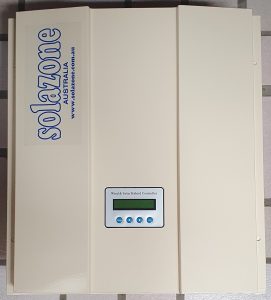
Reliable wind charger controller for 1500w to 2kw wind chargers, with built-in load dump for over-charging protection.
This wind controller is specially designed for off-grid wind generation systems. Appearance is neat, and operation is easy. The wind generator will charge the batteries safely and
efficiently.
Features:
- Adaptive matching of impedance between the wind generator and load to maximize energy utilization.
NOTE: there is internal resistance in Wind generators, batteries, and loads. Works according to the impedance matching principle, when input impedance equals to output impedance, the power utilization will be maximum. - Protects the wind generator from over-revolution speed, over-voltage, and over-current.
NOTE: Max. revolution speed, max voltage, and max current of wind generator can be set. Once the revolution speed, voltage or current exceed the set values, PWM intelligent unloading
will automatically start to protect the wind generator and controller. - Max. charging current limit intelligent
NOTE: During commissioning, set the battery capacity in the controller, and the controller will calculate the max. safe charging current based on the battery capacity, and will limit the charging current to protect the battery and extend the battery life. - Wind generator charging switch.
NOTE: The user can turn on or off the wind generator charging. - Boost & Buck function for wind generator charging (if fitted).
NOTE: If the wind generator’s real output voltage is lower than the battery voltage, the controller will boost the output voltage of the wind generator to charge the battery. If the wind generator’s real output voltage is higher than the battery voltage, the controller will buck the output voltage of the wind generator to charge the battery. Under breeze, the resistance will slow down the wind generator giving small power output, but with the max. charging current limit and max. PowerPoint tracking technology, the output of the wind generator will be kept at the maximum power point. - LCD displays the voltage, charging current, and power of the wind generator.
- Optional RS232/RS485/GPRS communication points.
- The close tightness and conformal coating on the PCB board protect the controller from wet, dusty conditions and from static electricity.
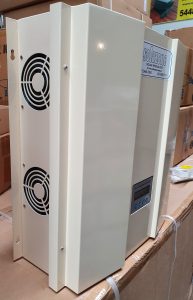
The HM Wind controller requires 150mm space each side to allow for the fan cooling.
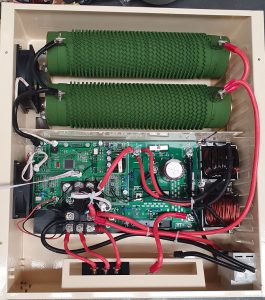
- YQHM Wind controller 1500w showing the enclosed dump load bank. For larger models, the load dump is supplied separately.
- Can be ordered as a straight wind generator controller, or as a hybrid wind generator-solar panel controller.
- Comms connections need to be specified if required.
- Dimensions: 425 wide x 450 high x 175 deep.
- Weight: 16 kg.
Price June 2023 : $1495
Galaxy Wind & Solar Controllers.
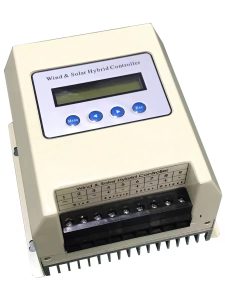
Galaxy Wind & Solar Hybrid Controller
- Wind turbine power 600w
- Rated voltage 24v
- Size 153 x 153 x 96.2 mm
- Type buck and boost
- Unloader dump load inside
- Display LCD screen – voltage, battery capacity, current, load mode
- Communication interface standard RS485, RS232 optional, GPRS remote monitoring
Price November 2023: $675

